Don't wanna be here? Send us removal request.
Text

In the fast-paced world of manufacturing, staying ahead of the curve requires embracing cutting-edge technologies that can enhance efficiency, productivity, and quality. Among these technologies, computer vision stands out as a powerful tool that revolutionizes various aspects of the manufacturing process. From quality control to predictive maintenance, computer vision offers a multitude of use cases that empower manufacturers to optimize operations and drive innovation.
For more information :https://lnkd.in/d4J6_-7w
#artificial intelligence#custom software development#data analytics#ai#automation#it consulting#digital transformation#datascience#transformation#cloud computing
0 notes
Text
Embracing the Future: Cloud-Native App Development
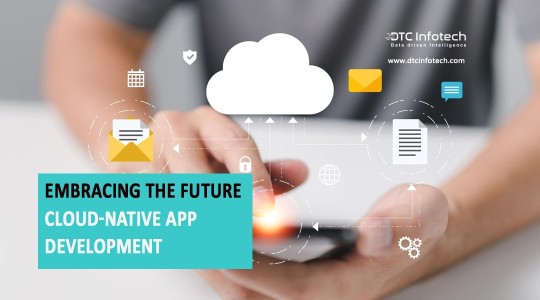
In today’s rapidly evolving digital landscape, businesses are under increasing pressure to innovate, deliver value to customers faster, and remain competitive. Cloud-native application development has emerged as a game-changer, enabling organizations to build and deploy more scalable, resilient, and agile applications than ever before. In this blog, we’ll explore the essence of cloud-native app development and why it’s the future of software engineering.
What Does “Cloud-Native” Mean?
At its core, being “cloud-native” means designing, building, and operating applications that fully leverage cloud computing’s capabilities. These applications are specifically optimized to run in cloud environments, such as Amazon Web Services (AWS), Microsoft Azure, or Google Cloud Platform (GCP).
Key Principles of Cloud-Native App Development:
Microservices Architecture: Cloud-native apps are typically built using a microservices architecture, where an application is divided into smaller, independent services. This makes it easier to develop, deploy, and scale individual components.
Containerization: Containers, such as Docker, package applications and their dependencies into a standardized unit that can run consistently across different environments.
Orchestration: Tools like Kubernetes manage the deployment, scaling, and orchestration of containers, ensuring efficient use of resources and high availability.
Continuous Integration/Continuous Deployment (CI/CD): Automated CI/CD pipelines enable rapid development, testing, and deployment of new features, reducing time-to-market.
Resilience and Self-Healing: Cloud-native apps are designed to handle failures gracefully, with automated recovery mechanisms and self-healing capabilities.
Benefits of Cloud-Native App Development:
Scalability: Applications can easily scale up or down based on demand, ensuring optimal resource utilization and cost-efficiency.
Flexibility: Cloud-native architecture allows developers to choose the best tools and services for each component, enhancing flexibility and innovation.
Cost-Efficiency: With pay-as-you-go pricing models, organizations can avoid overprovisioning and reduce infrastructure costs.
Enhanced Security: Cloud providers offer robust security features, and cloud-native apps can take advantage of these to bolster their own security.
Faster Time-to-Market: The automation and agility of cloud-native development lead to quicker development cycles and faster feature delivery.
Real-World Applications:
Cloud-native app development has already made its mark in various industries:
E-commerce: Retailers use cloud-native apps to handle fluctuating website traffic during sales events.
Healthcare: Electronic health record (EHR) systems benefit from cloud-native architecture to ensure data availability and security.
Financial Services: Banking and fintech companies leverage cloud-native solutions for real-time transactions and analytics.
Challenges and Considerations:
While the benefits are clear, adopting cloud-native practices isn’t without challenges. Organizations must consider factors like data security, compliance, and cultural shifts in their journey to cloud-native development.
In Conclusion:
Cloud-native app development represents a significant shift in how businesses build and deliver software. By embracing cloud-native principles, organizations can stay ahead in the digital race, responding quickly to market changes, and delivering exceptional experiences to customers. It’s not just about technology; it’s about transforming the way we build and think about applications in the cloud-native era.
For more Information , Visit Website :
#artificial intelligence#custom software development#data analytics#ai#automation#it consulting#transformation#digital transformation#datascience#cloud computing
0 notes
Text
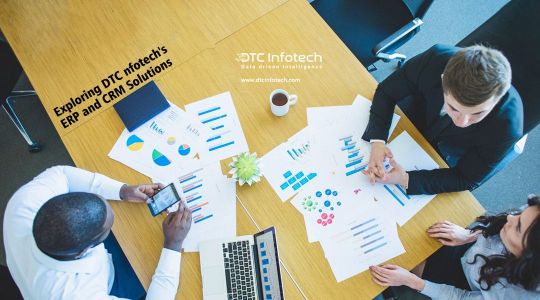
Discover the transformative power of DTC Infotech's ERP and CRM solutions in revolutionizing business efficiency. Seamlessly integrating essential operations and customer relationship management, our innovative technologies streamline workflows, optimize resource allocation, and enhance customer engagement. With DTC Infotech, unlock the potential for unparalleled productivity and growth, empowering your organization to thrive in today's dynamic business environment.
For more information: https://lnkd.in/gNcTAnSH
#artificial intelligence#custom software development#data analytics#ai#automation#it consulting#transformation#digital transformation#datascience#cloud computing
0 notes
Text
Unveiling the Art and Science of Web Engineering: Crafting the Digital Future
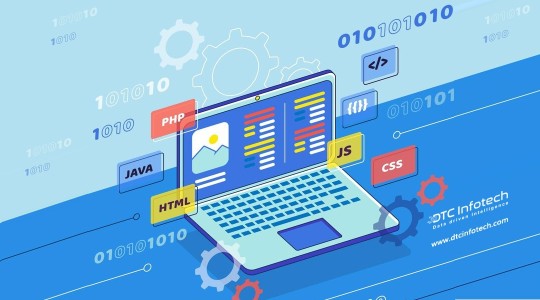
Unveiling the Art and Science of Web Engineering: Crafting the Digital Future
In the ever-evolving landscape of the digital world, web engineering stands as the backbone of our online experiences. It’s the intricate art and scientific precision that breathe life into the websites and applications we interact with daily. Let’s embark on a journey to explore the nuances and significance of web engineering, the driving force behind the digital transformation era.
Understanding Web Engineering:
Web engineering is more than just coding; it’s a multidisciplinary field that encompasses various aspects of software development, design, and project management. It’s the orchestration of technologies, methodologies, and creative insights to build robust, user-friendly, and scalable web solutions.
The Components of Web Engineering:
Front-End Development: The user interface (UI) and user experience (UX) design create the face of a website. Technologies like HTML, CSS, and JavaScript bring designs to life and ensure seamless interactions.
Back-End Development: The engine behind the scenes, managing databases, server-side logic, and ensuring smooth functionality. Technologies such as Node.js, Python, Ruby on Rails, or PHP power the back end.
Full-Stack Development: Full-stack developers are the Swiss Army knives, proficient in both front-end and back-end technologies. They ensure the entire web application functions cohesively.
Web Architecture: The blueprint of a web application, deciding how components interact. Microservices, serverless architecture, and other paradigms shape the architecture.
DevOps and Continuous Integration/Continuous Deployment (CI/CD):Ensuring collaboration between development and operations teams.CI/CD pipelines automate testing and deployment processes for efficiency.
The Role of Web Engineering in Digital Transformation:
Responsive Design: Crafting websites that adapt to various devices, ensuring a seamless experience for users on smartphones, tablets, or desktops.
Performance Optimization:Utilizing techniques to enhance website speed and performance, reducing load times and improving user satisfaction.
Security Measures:Implementing robust security protocols to protect against cyber threats and safeguard user data.
Scalability:Designing applications that can scale effortlessly to accommodate growing user bases and increased demands.
Challenges and Innovations:
Cross-Browser Compatibility: Overcoming the challenges of ensuring a consistent experience across different web browsers.
Progressive Web Apps (PWAs): Blurring the lines between web and mobile applications, providing app-like experiences on the web.
WebAssembly (Wasm): Empowering web applications with near-native performance through binary code execution in browsers.
The Future of Web Engineering:
As we gaze into the future, the role of web engineering becomes even more pivotal. Emerging technologies like Artificial Intelligence, Augmented Reality, and the Internet of Things will further shape the landscape. The quest for creating faster, more secure, and immersive web experiences continues, and web engineers are at the forefront of this digital evolution.
In conclusion, web engineering is an amalgamation of creativity and technology, continually pushing the boundaries of what’s possible in the digital realm. It’s not just about writing code; it’s about crafting digital experiences that resonate with users and drive the digital revolution forward.
#artificial intelligence#custom software development#data analytics#ai#automation#it consulting#transformation#digital transformation#datascience#cloud computing
0 notes
Text
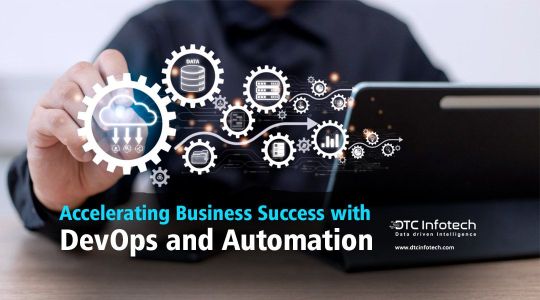
DevOps and automation are essential for accelerating business success by streamlining software development and operations. By fostering collaboration between development and IT teams, DevOps breaks down traditional silos, enhancing efficiency and productivity. Automation handles repetitive tasks, enables continuous integration and deployment (CI/CD), and ensures consistent, high-quality software releases. These practices not only speed up the time-to-market for new features and updates but also improve software reliability and scalability. In today’s competitive market, DevOps and automation drive innovation and agility, allowing businesses to respond swiftly to changing customer needs and market dynamics. For more information : https://lnkd.in/gdkMe7cw
#artificial intelligence#custom software development#data analytics#ai#automation#it consulting#transformation#digital transformation#datascience#cloud computing
0 notes
Text
Mastering Mobile Development: Building the Future in the Palm of Your Hand

In the ever-evolving landscape of technology, mobile development stands at the forefront, driving innovation and reshaping the way we interact with the digital world. From powerful applications that enhance our daily lives to groundbreaking solutions that revolutionize industries, mobile development is a dynamic field that continues to push boundaries. This blog delves into the transformative journey of mobile development, exploring its key aspects and the impact it has on our connected lives.
The Rise of Mobile Development: The inception of mobile development marked a paradigm shift, enabling developers to create applications tailored specifically for mobile devices. The rise of smartphones and tablets brought forth a new era, propelling mobile development into the spotlight. With platforms like iOS and Android, developers gained the tools to craft immersive and feature-rich applications, forever changing the way we communicate, work, and entertain ourselves.
Key Aspects of Mobile Development:
Platform Diversity: Mobile development encompasses both iOS and Android platforms, each with its unique set of tools, languages, and user interfaces. Developers adept in languages like Swift (for iOS) and Kotlin/Java (for Android) navigate the intricacies of these platforms to create seamless and responsive applications.
User-Centric Design: Mobile applications thrive on user experience. Mobile developers focus on creating intuitive and visually appealing interfaces, ensuring that users can effortlessly navigate through applications. User-centric design principles drive engagement and foster positive interactions.
Cross-Platform Development: The demand for cross-platform solutions has surged, leading to the emergence of frameworks like React Native and Flutter. These frameworks enable developers to write code once and deploy it on multiple platforms, streamlining the development process and reaching a broader audience.
Integration of Advanced Technologies: Mobile development is at the forefront of integrating cutting-edge technologies. From augmented reality (AR) and virtual reality (VR) to artificial intelligence (AI) and the Internet of Things (IoT), mobile applications are becoming increasingly sophisticated, offering users immersive and intelligent experiences.
Impact on Industries: Mobile development has a profound impact on various industries, ranging from healthcare and finance to education and entertainment. Mobile applications have streamlined business operations, enhanced accessibility to services, and transformed the way we consume information. The healthcare sector, for instance, has witnessed the rise of telemedicine applications, while the finance industry has embraced mobile banking, making services more accessible than ever.
The Future of Mobile Development: As we look ahead, the future of mobile development holds exciting possibilities. The continued evolution of 5G technology promises faster and more reliable connections, enabling the seamless integration of data-intensive applications. Emerging trends like progressive web apps (PWAs) and the Internet of Behaviors (IoB) are set to shape the next phase of mobile development, offering enhanced user experiences and unprecedented connectivity.
Conclusion: Mobile development is not just a technological evolution; it is a cultural phenomenon that has woven itself into the fabric of our daily lives. From simplifying tasks to fostering innovation, mobile applications continue to be a driving force in the digital era. As we navigate the future, the journey of mobile development promises to be dynamic, transformative, and filled with endless possibilities.
#artificial intelligence#custom software development#data analytics#ai#automation#it consulting#digital transformation#datascience#transformation#cloud computing
0 notes
Text
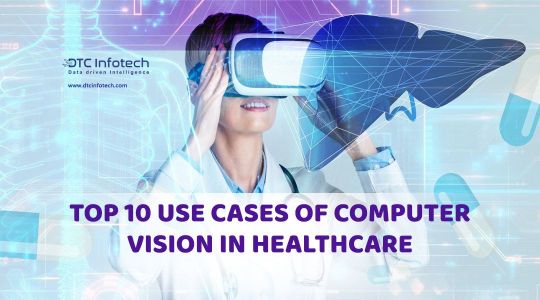
#Computervision is revolutionizing #healthcare with applications such as analyzing medical images for accurate diagnoses, detecting cancer early, and providing real-time surgical assistance. It enables remote patient monitoring, tracks disease progression, and assists in skin condition analysis. Computer vision also automates pathology, enhances patient identification, monitors mobility for rehabilitation, and powers augmented reality in medical training. These use cases enhance diagnostic accuracy, improve patient care, and streamline healthcare operations, leading to better health outcomes. For more information: https://dtcinfotech.com
#artificial intelligence#custom software development#data analytics#ai#automation#it consulting#transformation#digital transformation#datascience#cloud computing
0 notes
Text
Elevating User Experiences: The Art and Science of UI/UX Engineering
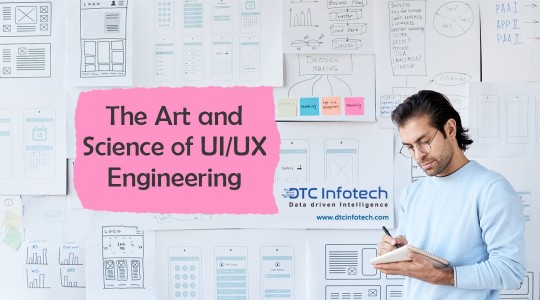
In the ever-evolving digital landscape, where user interactions with technology shape our daily lives, the role of User Interface (UI) and User Experience (UX) engineering has become paramount. UI/UX engineering is the seamless integration of design and technology, aiming to create intuitive, visually appealing, and user-centric digital experiences. This blog explores the key aspects, challenges, and trends in UI/UX engineering that contribute to crafting engaging and memorable user interfaces.
Understanding UI and UX:
User Interface (UI) refers to the visual elements of a digital product, such as buttons, icons, and layouts, which users interact with. It focuses on creating an aesthetically pleasing and visually comprehensible design. On the other hand, User Experience (UX) encompasses the overall feel and usability of a product, taking into account the user’s emotions, perceptions, and ease of interaction. A successful UI/UX design ensures that users not only find a product visually appealing but also have a seamless and enjoyable experience while using it.
Key Principles of UI/UX Engineering:
User-Centered Design: UI/UX engineers prioritize understanding the target audience to tailor designs that resonate with users. This involves conducting user research, creating user personas, and gathering feedback to inform design decisions.
Consistency: Maintaining a consistent design across all elements of an interface promotes a sense of familiarity and predictability. Consistency in layout, color schemes, and interactive elements enhances user understanding and navigation.
Clarity and Simplicity: Clear and simple designs reduce cognitive load for users. UI/UX engineers strive to eliminate unnecessary complexities, presenting information in a straightforward manner to enhance user comprehension.
Responsive Design: With the proliferation of various devices and screen sizes, UI/UX engineers prioritize creating responsive designs that adapt to different platforms. This ensures a seamless experience for users, whether they’re on a desktop, tablet, or smartphone.
Challenges in UI/UX Engineering:
Technological Constraints: Rapid advancements in technology present both opportunities and challenges. UI/UX engineers must stay updated on the latest tools and technologies to create innovative and future-proof designs.
Balancing Aesthetics and Functionality: Achieving a balance between an aesthetically pleasing design and functional usability is a constant challenge. Engineers must ensure that visual elements not only look good but also contribute to a positive user experience.
Evolution of User Expectations: As users become more sophisticated, their expectations for seamless and intuitive interfaces rise. UI/UX engineers need to stay ahead of trends and continually innovate to meet evolving user demands.
Trends in UI/UX Engineering:
Augmented Reality (AR) and Virtual Reality (VR):The integration of AR and VR in UI/UX design opens new dimensions for immersive and interactive experiences. UI/UX engineers are exploring ways to leverage these technologies to enhance user engagement.
Micro interactions: Small, subtle animations and micro interactions contribute to a more delightful user experience. UI/UX engineers focus on incorporating these details to add polish and personality to interfaces.
Voice User Interface (VUI):The rise of voice-activated devices has led to a growing emphasis on designing interfaces that are not only visually appealing but also optimized for voice interactions. UI/UX engineers are adapting to this shift in user behavior.
Conclusion:
UI/UX engineering is a dynamic field that continues to evolve as technology and user expectations advance. Successful designs require a harmonious blend of aesthetics, functionality, and user-centric principles. As we move into an era of increasingly complex digital interactions, the role of UI/UX engineers remains pivotal in shaping the way users engage with technology. By staying abreast of trends, understanding user needs, and embracing innovative technologies, UI/UX engineers play a crucial role in creating digital experiences that leave a lasting impact.
#artificial intelligence#custom software development#data analytics#ai#automation#it consulting#transformation#digital transformation#datascience#cloud computing
0 notes
Text
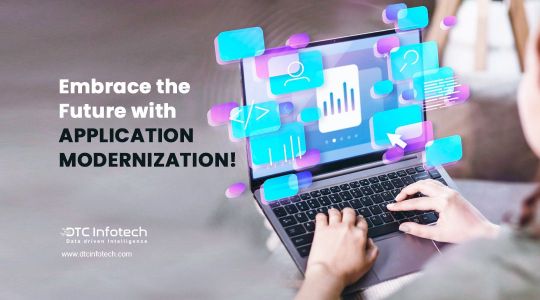
⚡ Embrace the Future with Application Modernization! ⚡ In today's fast-paced tech world, staying ahead means modernizing your applications.
💡 Did you know 72% of enterprises are on their journey toward app modernization? 💡 60% of CIOs plan to boost investment in modernization for efficiency, cost reduction, and better user experiences. 💡 55% of companies using cloud-native solutions, microservices, and containerization report improved agility and faster time-to-market. Stay competitive and future-ready! Let's transform your legacy systems into powerful, modern applications.
Visit our website www.dtcinfotech.com to learn more.
#artificial intelligence#custom software development#data analytics#ai#automation#it consulting#transformation#digital transformation#datascience#cloud computing
0 notes
Text

Unleashing Creativity: Exploring the Power and Potential of Generative Artificial Intelligence (GenAI)
In the ever-evolving landscape of artificial intelligence, one revolutionary trend stands out — Generative Artificial Intelligence (GenAI). GenAI, a subset of AI, goes beyond traditional machine learning by allowing systems to generate new, unique content. This innovative approach holds immense promise, with a wide range of use cases, solutions, and applications across various industries.
Use Cases:
Content Creation:
GenAI enables the creation of diverse content, from text and images to videos. It’s a game-changer for marketers, writers, and designers seeking fresh, engaging content.
Design and Creativity:
Designers leverage GenAI to generate unique designs, logos, and artworks. This streamlines the creative process and sparks new possibilities in graphic design.
Language Translation:
GenAI powers advanced language translation models, breaking down language barriers and facilitating seamless communication on a global scale.
Data Augmentation:
In data science, GenAI aids in data augmentation, generating synthetic data to enhance model training and improve the robustness of machine learning algorithms.
Personalized User Experiences:
Businesses use GenAI to analyze user behavior and preferences, providing personalized recommendations, enhancing customer experiences, and increasing user engagement.
Solutions:
Text Generation Models: OpenAI’s GPT (Generative Pre-trained Transformer) models are leading the way in natural language processing, demonstrating remarkable capabilities in generating coherent and contextually relevant text.
Image Synthesis:
GenAI, particularly through models like DALL-E, allows for the generation of diverse images based on textual descriptions. This has applications in creative fields and product design.
Video Synthesis:
Video synthesis using GenAI is transforming the film and entertainment industry by automating aspects of video production and enhancing special effects.
Conversational AI:
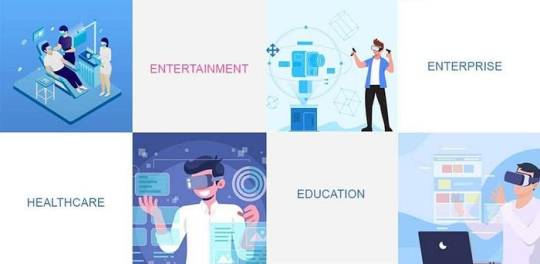
Industry Applications:
Healthcare:
GenAI assists in medical image analysis, drug discovery, and personalized treatment plans, enhancing the efficiency and accuracy of healthcare processes.
Finance:
In the financial sector, GenAI powers fraud detection, risk assessment, and algorithmic trading, optimizing decision-making processes.
Manufacturing:
GenAI contributes to predictive maintenance, quality control, and supply chain optimization, boosting efficiency and reducing operational costs.
Retail:
Retailers use GenAI for demand forecasting, personalized marketing, and inventory management, creating a more responsive and customer-centric business model.
Education:
GenAI enhances the education sector through personalized learning experiences, intelligent tutoring systems, and automated grading.
Conclusion:
GenAI represents a paradigm shift in the capabilities of artificial intelligence, offering innovative solutions and applications across diverse industries. As organizations increasingly harness the power of Generative Artificial Intelligence, we can expect to witness unprecedented advancements, efficiencies, and transformative changes in the way we work, create, and interact with technology. The journey of GenAI has only just begun, and the possibilities it unfolds are both exciting and limitless.
For more Information , Visit:
https://dtcinfotech.com/
#artificial intelligence#custom software development#data analytics#ai#automation#it consulting#transformation#digital transformation#datascience#cloud computing
0 notes
Text
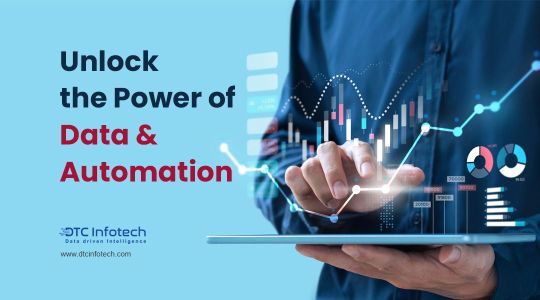
Unlock the Power of Data & Automation! Did you know that according to Gartner, by 2025, 75% of enterprises will shift from piloting to operationalizing AI, driving a 5x increase in streaming data and analytics infrastructures? 🔶 McKinsey reports that data-driven organizations are 23 times more likely to acquire customers and 19 times more likely to be profitable. 🔶Automation is transforming industries, with Forrester predicting that automation will eliminate 29% of jobs by 2030, but will also create 13% more, focusing on higher-value work. Embrace the future of data and automation to stay ahead in the competitive landscape!
🔗 Visit us www.dtcinfotech.com & learn more.
#artificial intelligence#custom software development#data analytics#ai#automation#it consulting#transformation#digital transformation#datascience#cloud computing
0 notes
Text
AI’s Impact on Logistics and Transportation Management
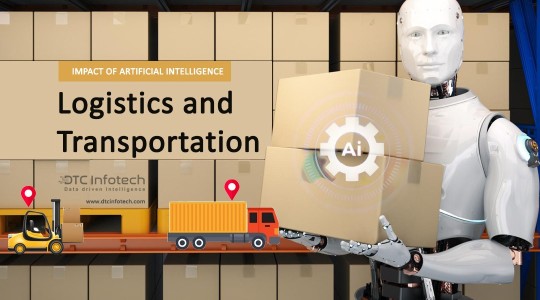
In the fast-paced world of logistics and transportation, efficiency is key to success. The ability to optimize routes, streamline operations, and minimize costs can make all the difference in meeting customer demands and staying competitive. With the advent of Artificial Intelligence (AI), the industry is experiencing a transformative shift towards smarter, more data-driven approaches to management. Let’s delve into the role of AI in revolutionizing logistics and transportation management.
Optimized Route Planning
One of the most significant contributions of AI to logistics and transportation is optimized route planning. AI algorithms analyze vast amounts of data, including traffic patterns, weather conditions, and delivery schedules, to identify the most efficient routes for transportation vehicles. By minimizing travel time and fuel consumption, AI-driven route planning not only reduces operational costs but also improves delivery reliability and customer satisfaction.
Predictive Maintenance
AI-powered predictive maintenance is another game-changer in the logistics and transportation industry. By continuously monitoring vehicle health and performance data, AI algorithms can predict potential equipment failures before they occur. This proactive approach to maintenance minimizes downtime, prevents costly breakdowns, and extends the lifespan of transportation assets, ultimately enhancing operational efficiency and fleet reliability.
Demand Forecasting
Accurate demand forecasting is essential for optimizing inventory levels, managing supply chain operations, and meeting customer demands. AI algorithms analyze historical sales data, market trends, and external factors to predict future demand patterns with greater accuracy than traditional forecasting methods. By anticipating changes in demand, logistics and transportation companies can optimize inventory management, reduce stockouts, and improve overall supply chain efficiency.
Enhanced Customer Experience
AI-driven technologies, such as chatbots and virtual assistants, are revolutionizing customer service in the logistics and transportation industry. These intelligent systems can provide real-time updates on shipment status, answer customer inquiries, and facilitate seamless communication between customers and service providers. By offering personalized, responsive support, AI-powered customer service solutions enhance the overall customer experience and foster long-term loyalty.
Supply Chain Optimization
AI plays a crucial role in optimizing supply chain operations, from warehouse management to distribution logistics. Advanced AI algorithms analyze supply chain data in real-time to identify inefficiencies, streamline processes, and optimize inventory levels. By automating repetitive tasks and optimizing resource allocation, AI-driven supply chain solutions improve operational efficiency, reduce costs, and enhance overall supply chain performance.
Conclusion
In conclusion, AI is revolutionizing logistics and transportation management by introducing smarter, more data-driven approaches to optimization and decision-making. From optimized route planning and predictive maintenance to demand forecasting and supply chain optimization, AI-driven technologies are transforming every aspect of the logistics and transportation industry. By embracing AI-powered solutions, companies can unlock new levels of efficiency, reliability, and competitiveness in today’s dynamic business landscape.
For more information : https://dtcinfotech.com/ais-impact-on-logistics-and-transportation-management/
#artificial intelligence#custom software development#data analytics#ai#automation#it consulting#transformation#digital transformation#datascience#cloud computing
0 notes
Text
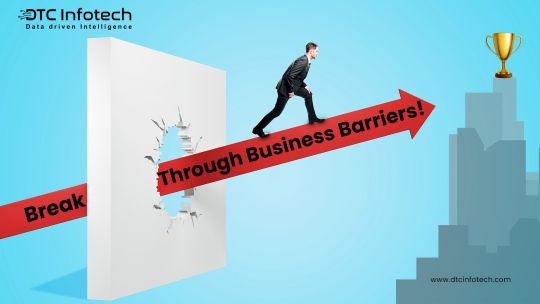
𝐁𝐫𝐞𝐚𝐤 𝐓𝐡𝐫𝐨𝐮𝐠𝐡 𝐁𝐮𝐬𝐢𝐧𝐞𝐬𝐬 𝐁𝐚𝐫𝐫𝐢𝐞𝐫𝐬! Is inefficiency, errors, or missed opportunities holding back your business growth? 𝐒𝐡𝐚𝐫𝐞 𝐘𝐨𝐮𝐫 𝐏𝐚𝐢𝐧 𝐏𝐨𝐢𝐧𝐭! 𝐃𝐚𝐭𝐚 𝐎𝐯𝐞𝐫𝐥𝐨𝐚𝐝: Too much data, too little insight? 𝐌𝐚𝐧𝐮𝐚𝐥 𝐄𝐫𝐫𝐨𝐫𝐬: Time-consuming corrections, reputations at stake? 𝐈𝐧𝐞𝐟𝐟𝐢𝐜𝐢𝐞𝐧𝐭 𝐎𝐩𝐞𝐫𝐚𝐭𝐢𝐨𝐧𝐬: Slow processes, missed opportunities? 𝐎𝐭𝐡𝐞𝐫 (comment below)? 𝐆𝐞𝐭 𝐒𝐭𝐚𝐫𝐭𝐞𝐝! Comment with your questions or concerns and we'll provide expert guidance.
#artificial intelligence#custom software development#data analytics#ai#automation#it consulting#transformation#digital transformation#cloud computing#robotic process automation
0 notes
Text
Is multi modal AI a game changer after GenAI

As I reflect on the evolution of artificial intelligence (AI) and its transformative impact on our world, I find myself captivated by the emergence of multi-modal AI — a paradigm shift that promises to redefine the boundaries of technological innovation and human-machine interaction.
Building upon the foundation laid by Generative AI (GenAI), multi-modal AI represents a monumental leap forward, not only empowering machines to perceive, understand, and generate information across multiple modalities with unprecedented accuracy and sophistication but also offering supreme empowerment to humans, catapulting actions with intelligent precision! No longer limited to processing single inputs such as text, image, video, or audio files alone, multi-modal AI systems possess the capacity to comprehend and generate information across multiple types or modes of data, including text, images, video, and audio.
This convergence of modalities represents a quantum leap in AI capabilities, enabling machines to perceive and interpret the world in a manner that more closely resembles human cognition. This also opens up the imagination to envision AI’s fast advancement toward reaching superhuman cognition in the near future, beyond the limitations of the five senses!
From a narrative standpoint, the implications of multi-modal AI are overwhelming. Imagine a world where machines can not only understand the nuances of language but also interpret the subtleties of visual imagery and auditory cues. Picture a digital assistant that can not only answer your questions but also generate lifelike images to accompany its responses or a self-driving car that can navigate complex environments by interpreting both visual and auditory signals.
Recent advancements in multi-modal AI from industry leaders like Google’s Vertex AI, Meta’s ImageBind, and others are accelerating the evolution of AI capabilities. Google’s Vertex AI offers a comprehensive platform for building, deploying, and managing machine learning models, enabling seamless integration of multiple modalities like text, images, and structured data.
Meanwhile, Meta’s ImageBind initiative focuses on enhancing image understanding and accessibility through computer vision and natural language processing. These developments highlight the transformative potential of multi-modal AI, driving innovation across industries and creating immense possibilities to pave the way for more inclusive and immersive experiences in the digital realm.
Multi-modal AI holds vast potential across industries, ranging from healthcare to education, entertainment, and autonomous vehicles, promising to revolutionize how we work, learn, and live. In healthcare, Aidoc utilizes multi-modal AI to analyze medical images, improving radiologists’ workflows by identifying abnormalities in CT scans, MRIs, and X-rays. Meanwhile, AI-driven platforms like Carnegie Learning’s Mika are reshaping education by providing personalized learning experiences, enhancing student outcomes in subjects like Developmental Math.
In the entertainment sector, Nvidia’s GauGAN uses multi-modal AI to create immersive virtual worlds from textual descriptions, offering new possibilities for design engineers, architects, and game developers. Additionally, in autonomous vehicles, multi-modal AI enhances safety and reliability by integrating inputs from various sensors, enabling self-driving systems like Waymo’s to navigate complex environments with precision and awareness, paving the way for widespread adoption in transportation systems of the future.
In conclusion, the rise of multi-modal AI marks a pivotal moment in the history of artificial intelligence — a game-changer that has the potential to reshape industries and enhance the way we interact with technology in our daily lives. As we continue to harness the power of multi-modal AI, the opportunities for innovation and impact are boundless, promising a future where AI works seamlessly alongside humans to drive progress and improve lives.
Are you ready to drive your enterprise with Multimodal AI strategy? Then talk to our experts to evaluate what are the applicable areas of your business leveraging Multimodal AI solutions As I reflect on the evolution of artificial intelligence (AI) and its transformative impact on our world, I find myself captivated by the emergence of multi-modal AI — a paradigm shift that promises to redefine the boundaries of technological innovation and human-machine interaction.
Building upon the foundation laid by Generative AI (GenAI), multi-modal AI represents a monumental leap forward, not only empowering machines to perceive, understand, and generate information across multiple modalities with unprecedented accuracy and sophistication but also offering supreme empowerment to humans, catapulting actions with intelligent precision! No longer limited to processing single inputs such as text, image, video, or audio files alone, multi-modal AI systems possess the capacity to comprehend and generate information across multiple types or modes of data, including text, images, video, and audio.
This convergence of modalities represents a quantum leap in AI capabilities, enabling machines to perceive and interpret the world in a manner that more closely resembles human cognition. This also opens up the imagination to envision AI’s fast advancement toward reaching superhuman cognition in the near future, beyond the limitations of the five senses!
From a narrative standpoint, the implications of multi-modal AI are overwhelming. Imagine a world where machines can not only understand the nuances of language but also interpret the subtleties of visual imagery and auditory cues. Picture a digital assistant that can not only answer your questions but also generate lifelike images to accompany its responses or a self-driving car that can navigate complex environments by interpreting both visual and auditory signals.
Recent advancements in multi-modal AI from industry leaders like Google’s Vertex AI, Meta’s ImageBind, and others are accelerating the evolution of AI capabilities. Google’s Vertex AI offers a comprehensive platform for building, deploying, and managing machine learning models, enabling seamless integration of multiple modalities like text, images, and structured data.
Meanwhile, Meta’s ImageBind initiative focuses on enhancing image understanding and accessibility through computer vision and natural language processing. These developments highlight the transformative potential of multi-modal AI, driving innovation across industries and creating immense possibilities to pave the way for more inclusive and immersive experiences in the digital realm.
Multi-modal AI holds vast potential across industries, ranging from healthcare to education, entertainment, and autonomous vehicles, promising to revolutionize how we work, learn, and live. In healthcare, Aidoc utilizes multi-modal AI to analyze medical images, improving radiologists’ workflows by identifying abnormalities in CT scans, MRIs, and X-rays. Meanwhile, AI-driven platforms like Carnegie Learning’s Mika are reshaping education by providing personalized learning experiences, enhancing student outcomes in subjects like Developmental Math.
In the entertainment sector, Nvidia’s GauGAN uses multi-modal AI to create immersive virtual worlds from textual descriptions, offering new possibilities for design engineers, architects, and game developers. Additionally, in autonomous vehicles, multi-modal AI enhances safety and reliability by integrating inputs from various sensors, enabling self-driving systems like Waymo’s to navigate complex environments with precision and awareness, paving the way for widespread adoption in transportation systems of the future.
In conclusion, the rise of multi-modal AI marks a pivotal moment in the history of artificial intelligence — a game-changer that has the potential to reshape industries and enhance the way we interact with technology in our daily lives. As we continue to harness the power of multi-modal AI, the opportunities for innovation and impact are boundless, promising a future where AI works seamlessly alongside humans to drive progress and improve lives.
Are you ready to drive your enterprise with a Multimodal AI strategy? Then talk to our experts to evaluate what are the applicable areas of your business leveraging Multimodal AI solutions.
#artificial intelligence#custom software development#data analytics#ai#automation#it consulting#transformation#digital transformation
0 notes
Text

𝐀𝐫𝐞 𝐘𝐨𝐮 𝐆𝐞𝐭𝐭𝐢𝐧𝐠 𝐭𝐡𝐞 𝐌𝐨𝐬𝐭 𝐟𝐫𝐨𝐦 𝐘𝐨𝐮𝐫 𝐃𝐚𝐭𝐚? DTC Infotech's Data Analytics Solutions will help you make informed decisions and drive growth.
At DTC Infotech, we help organizations unlock their data's value with tailored analytics solutions, predictive insights, and real-time intelligence, driving operational efficiency, customer satisfaction, and sustainable growth.
Learn more about our data analytics solutions:
www.dtcinfotech.com
#artificial intelligence#custom software development#data analytics#ai#automation#it consulting#transformation#digital transformation#datascience
0 notes
Text
Combatting Credit Card Fraud with Python-Based Detection Systems

With the rapid advancement of technology and the proliferation of e-service payment solutions like e-commerce and mobile payments, credit card transactions have become a staple of daily life. As the adoption of cashless transactions grows, so does the frequency and sophistication of fraudulent activities. Fraudsters continuously adapt their methods to evade detection, making credit card fraud — a crime involving unauthorized card usage or unusual transaction patterns — a growing concern. In recent years, the incidence of credit card breaches has risen alarmingly.
To address this pressing issue, our Python-based Credit Card Fraud Detection System offers a robust solution to safeguard credit card transactions. This system ensures secure transactions for credit card users when they make electronic payments for goods and services. We employ the Random Forest Algorithm (RFA) to identify fraudulent transactions and analyze their frequency.
System Overview
Our Python-based Credit Card Fraud Detection System features a single module: Admin. To access the system, administrators must log in using a two-factor authentication process. This involves entering their email address and password, followed by an OTP sent to their registered email.
Admin Functionality
Once logged in, the admin can:
View Customer Details: Access comprehensive information about all users, including name, address, phone number, and transaction history.
Create Payment Links: Generate payment links by entering the transaction amount and country. This functionality is crucial for initiating secure transactions.
Monitor Fraudulent Customers: Identify and review customers flagged for suspicious activities.
When a payment link is created, customers must provide their name, phone number, billing address, shipping address, and CNIC number. Upon submission, the system applies predefined rules to classify the transaction. These classifications include:
Completed Transactions: Successfully processed payments.
Under-Review Transactions: Payments pending further investigation.
Declined Transactions: Payments that failed due to rule violations.
Flagged Transactions: Payments marked for potential fraud.
Only transactions that pass all security checks and rules are processed successfully, ensuring a high level of security and fraud prevention.
By integrating advanced machine learning techniques, our system enhances the ability to detect and prevent fraudulent activities, providing peace of mind to credit card users and financial institutions alike. The implementation of such a system is crucial in maintaining the integrity of electronic payment processes in an increasingly digital world.
For more information visit:
DTC Infotech
#artificial intelligence#custom software development#data analytics#ai#automation#it consulting#transformation#digital transformation#cloud computing
0 notes
Text

𝐌𝐢𝐜𝐫𝐨𝐬𝐨𝐟𝐭 𝐃𝐲𝐧𝐚𝐦𝐢𝐜𝐬 𝟑𝟔𝟓 𝐁𝐮𝐬𝐢𝐧𝐞𝐬𝐬 𝐂𝐞𝐧𝐭𝐫𝐚𝐥 is a robust, cloud-based Enterprise Resource Planning solution designed to meet the business management needs of small to medium-sized businesses and larger enterprises.
#DigitalTransformation#custom software development#data analytics#cloudcomputing#it solutions#artificial intelligence#automation#ai#transformation
0 notes